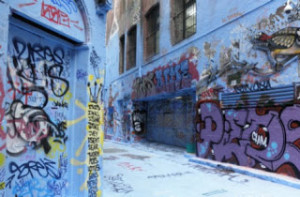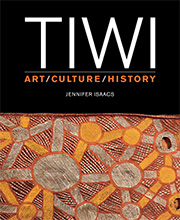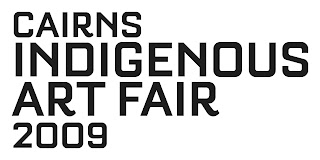Street art blues in Rutledge Lane
A bit of back-story casts a dim light on the officially-sanctioned blue-ing of a Melbourne street art icon.
Rutledge Lane is a horseshoe-shaped lane that runs behind Hosier Lane, located in between Flinders St and Flinders Lane. It wraps around the building housing the bar Misty and the now defunct street art gallery Until Never, whose director, Andrew Macdonald, aka Andy Mac, began CityLights Projects in 1996.
In many ways, Mac was a pioneer. He was the first Australian gallery director to see the potential in graffiti and street art on such a large scale, he battled the Melbourne City Council for years and he supported many artists early in their careers, many of which have gone on to have significant careers as fine artists with large commercial galleries. He sought and obtained permission from the owners of buildings in the Hosier, Rutledge and also Centre Place laneways for street art, graffiti and his own curated outdoor art light boxes. CityLights held, over the course of over fifteen years, exhibitions by some of Australia’s brightest and finest artists and graffiti writers. A significant number of whom have gone on to become some of Australia’s most significant and interesting street and contemporary artists: Ha Ha, Ash Keating, Dlux (James Dodd), Phibs, Rone, Vexta, Nails, Civil, Anthony Lister, Deb, Al Stark, Braddock, Stormie Mills, Marc de Jong, Nat & Ali, Ben Frost, Adrian Doyle, David Noonan and Monica Tichachek. It hosted exhibitions by international street artists such as Blek Le Rat and Shepherd Fairey (Obey).
Exhibitions were held with artists living in New York, London, Dublin and Vienna, amongst other places.Amongst the street art exhibitions were those by graffiti writers: the Pieces exhibition in 2004 featured some strong names in graffiti, including old school kings Duel and Puzle, and significant mid-school writers Bonez, Renks, Phibs and Jors. Old school Melbourne writer Paris also exhibited there.
Looking back over the exhibitions held at CityLights, they are actually quite astounding in their diversity and vision: exhibitions were held of all female graffiti writers and street artists: not the usual ‘all girl’ exhibition, but one focusing on the theme of confrontation. Over the years CityLights hosted contemporary art photographers, installation artists, conceptual artists, projects with young people in Aboriginal communities in Western Australia and with the Aboriginal art centre on the Mornington Peninsula, Baluk Arts.
And many of these artists, probably all of them at once time of another, produced work on the walls of Hosier and Rutledge Lanes, both officially, as part of an exhibition, and also unofficially. Thus the walls became a compendium of significant street artists. There were also graffiti writers’ tags and pieces. It was a living, breathing entity. Andy Mac encouraged any visiting artists or writers to paint the walls. I remember visiting with the now late Aboriginal artist Ian Abdulla, in 2004. Mac urged him to paint on the walls, Abdulla could not be convinced: as an Aboriginal man, he said, he would be the one arrested, not us, despite our insistence that he had permission from the building’s owners.
Mac has left now; the place has no guardian. It may have become more scruffy and run down, which was partly part of its appeal, but nonetheless I was shocked when street artist Adrian Doyle this week painted the entire lane blue, with the backing of the City of Melbourne and RMIT University.
In an artists’ statement, Doyle explained that the blue had come from experiences with his family and childhood, and that:
‘Thus, I would like to incorporate my past and my present in a Street Art piece using the colour Empty-Nursery Blue, and only this colour. By using Empty-Nursery Blue to cover Hosier Lane, I am symbolically ‘coating’ my present with my past, it is reminder to me and anyone who is living, that you are a product of your former experiences, and you should be reminded of them as you work your way through your present and into your future. By doing this, I am claiming that a colour in its pure form can be street art or graffiti. This is a great conceptual link from fine art to street art, a link that is often lacking in the Melbourne Street Art scene. By bridging this gap, I hope to expose more people not only to Street Art, but also to the importance of art in general.’
I am not sure I understand Doyle’s thinking here. The very site he painted over, as a conceptual artwork, had in fact been host to numerous conceptual artworks over the years of CityLights: from massive melting ice-blocks to umbrella installations. This is not the birth of conceptual street art in Melbourne: it had already happened: it had just left these lanes in particular when Mac did.
The concept of ephemerality is undoubtedly central to both graffiti and street art. Graffiti writers spend huge amounts of time and energy on works that may not even last twenty-four hours. How many masterpieces have vanished within days, weeks or months, been cleaned off or painted over (the City of Melbourne itself has painted grey over numerous well-executed graffiti and street art works)? This is part of its nature. As with much Aboriginal art, it is the act itself that is important, rather than the result of the work decades down the track. And yet, for an art historian, this is tragedy. It recalls the Australian government’s destruction of the famed Honey Ant mural at Papunya, which was part of the birth of the desert art movement.
For me any work of substance: a tag with nice flow, a detailed wildstyle piece, a witty political slogan, a funny line, a multi-layered intricate stencil, all the variants and forms of good quality graffiti and street art are valid and interesting. I prefer them to a monotone concrete wall, I prefer them to remain, perhaps with others adding work around them, or to them, if done correctly. I love the moving gallery walls of trains and static outside gallery walls. This was the beauty of Rutledge: it was a street art and graffiti cacophony: layers of imagery: tags, slogans, stencils, stickers, graffiti pieces, portraits, built up over years. Every time I walked around Rutledge, I’d take photographs of something that would catch my eye. There were works up high that made you look up; graffiti makes you look at your landscape, your city scape differently. It makes you look up and around and in corners, where you wouldn’t usually look. It stimulates your eye and mind. It makes you wonder who painted it, what impetus drove someone to go to the effort of creating?
I enjoyed visiting it to see what had changed. Some pieces stayed for ages, some disappeared under others. I liked that it wasn’t just street art: graffiti writers were present too. The late 1990s to late 2000s were significant in Melbourne art: for it was really the time the street art movement was born. Graffiti had flourished in the 1980s (in Melbourne); while there are still some decent practitioners left, the golden age is over.
Street art is a newer movement but it too peaked in the early to mid 2000s. This was a time of the Gulf War, George W.Bush, dissent, activism, which was carried out in a major way through street art. There is little of that left. Pretty images appear; decorative ones. They are stylised and beautiful, and promote peace, not justice. Thus the popularity of street art has grown; it now appears on designer clothes trickling down to mass-produced t-shirts made in the very sweatshops the earlier street artists protested against.
Artists were emerging then and now have gone onto successful careers and are living all over the globe. There have been some interesting street artists appearing in recent years in Melbourne, but it is nothing like the energy and vitality of that time.
I think what fails for me about Doyle’s piece, is that as an artwork, it’s just not a particularly interesting idea. Reductionist colour works were interesting in the 1950s, when Rothko explored them. Rothko’s works contain shades and moods and colour variants. I am a researcher of colour and colour theory, I give lectures on the subject, exploring the symbolism in colour as investigated by artists such as Kandinsky to Rothko to Indigenous Australian artists. But this work to me is just well, simply, rather boring: it is not a burner, no matter how much Adrian Doyle may say it is. A burner is a Dondi car: design and technique and colour and form and movement all done under the cover of darkness, under pressure. To me, and to many graffiti writers and street artists, this is a massive buff. A buff provides a clean slate, true. Lord Mayor Robert Doyle himself said that:
”We are very proud of our street art in Melbourne and the epicentre of that is Hosier and Rutledge Lane and over the weekend my eponym Adrian Doyle has given us a blank canvas in Rutledge Lane…”
Whilst I would deny the original part of that sentence as historically true, perhaps now that street art brings advertisers, films and tourists, the Council is finally ‘very proud’ of it. Why then destroy it, why not create a new ‘blank canvas’ in another lane, let the street art and graffiti, which Melbourne can do really, really well, spread out into other parts of the city, bring more colour and vibrancy and life to the city, more creativity, give the kids more to do? Why cover over something that was a part of Melbourne, Australia and the world’s cultural history?
Furthermore, I find the ‘nursery’ aspect patronising. I understand Doyle’s personal relationship to the colour, which is mildly interesting, but painting a ‘children’s room’ is patronising to artists and writers who are largely grown adults. The lane is not just for kids. Taking a paternalistic, ‘I will save street art’ stance is testimony perhaps to an over-developed ego and the inclusion of the Lord Mayor and a large University in its backing, the paternalistic big fathers of the public, further adds to this feeling. Futhermore, I’m not really convinced that it is creatively interesting to claim a colour as street art, as a ‘tag’. That can be left up to the artist, I suppose, but to display it in such an over-the-top way, whilst going over so many other artists’ works, seems a little extreme.
I am a long-time fan of Doyle’s Blender Studios and his passion for street art. I know it’s not easy, especially in a world that blends over into graffiti, to stick your neck out. Graffiti writers can be both the most radical and most conservative people there are. And human beings don’t like change. But why does the council not create a diverse, educated group of people who can help advise on such matters? Curators, street artists, art critics, graffiti writers, artists? It worries me that the consultation seems to have been between the council, RMIT and a street artist, or perhaps a few of these. What about architectural historians? In the future, will they not be studying street art as a phenomenon of the twenty-first century?
It’s great that the City of Melbourne and its Lord Mayor and a large institution such as RMIT are not longer disinterested in street art, nor fighting it, nor removing it, or covering it up with grey paint. I’m just not convinced that covering it with any colour, whatever its artistically personal significance, is the right way forward.










Recent Comments